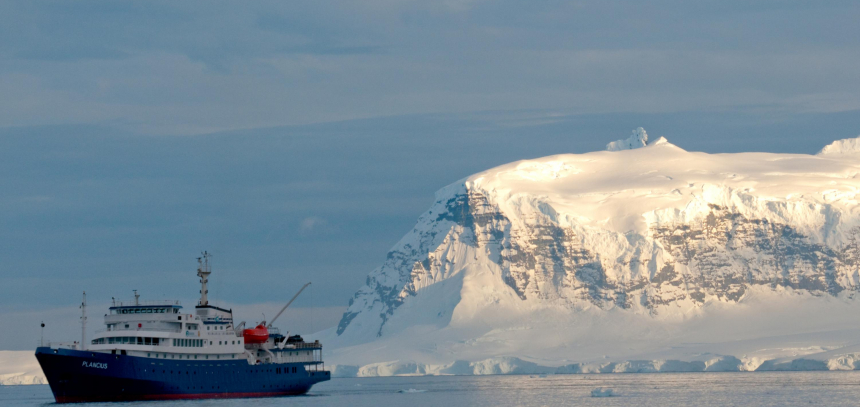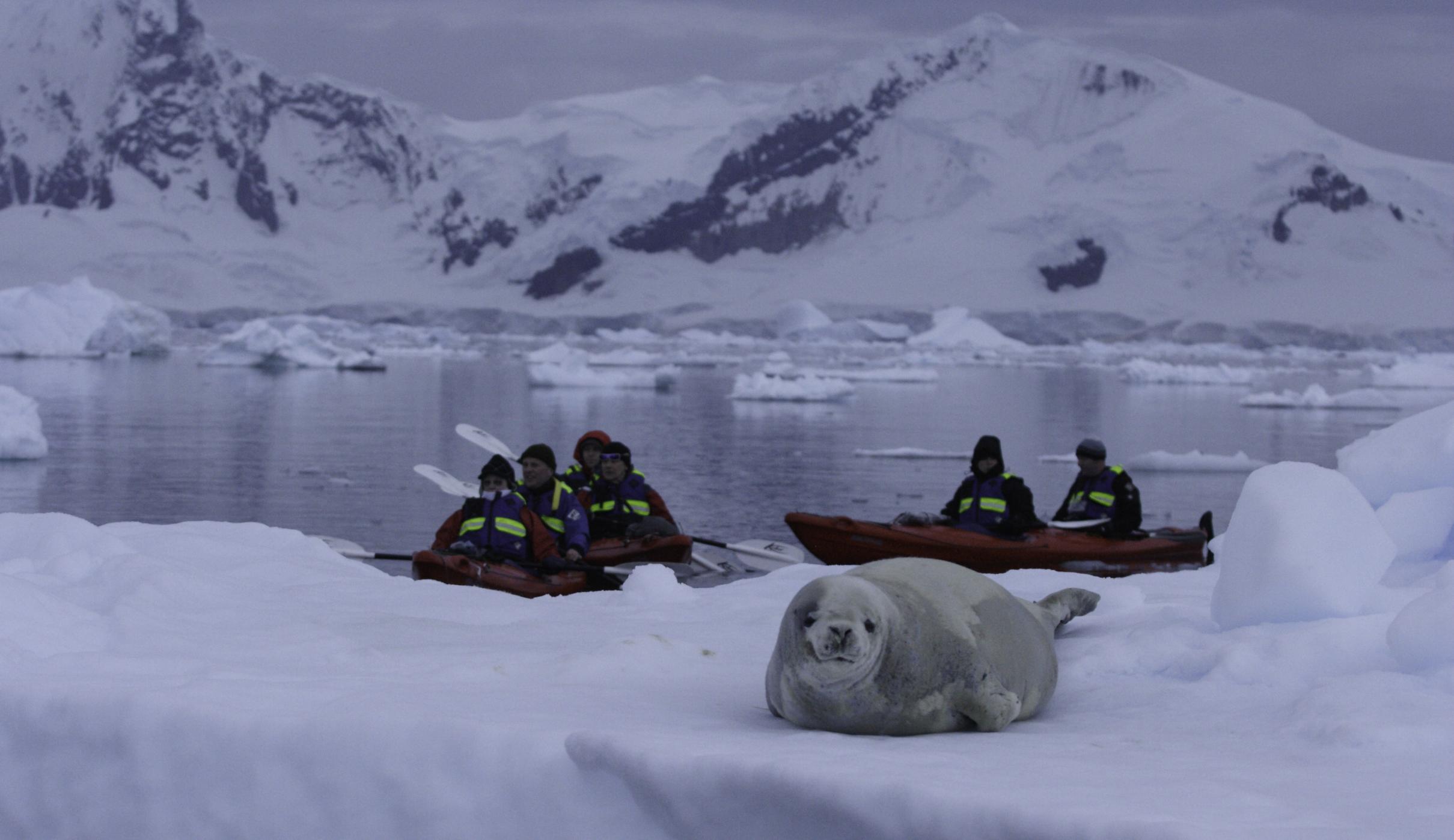Classic Antarctica and Deception Island aboard the M/V Plancius | Trip Itinerary

A typical itinerary to the Antarctic Peninsula is illustrated below. All itineraries are for guidance only. Programs may vary depending on local ice and weather conditions, the availability of landing sites and opportunities to see wildlife. The final itinerary will be determined by the Expedition Leader on board. Flexibility is paramount for expedition cruises
Go to: Additional information on the Antarctic Peninsula
Map of Antarctic Peninsula Route
 Itinerary
Itinerary
Day 1: Ushuaia In the afternoon, we embark in Ushuaia, Tierra del Fuego, Argentina, the southernmost city in the world located in the shadow of the Andes and right at the Beagle Channel shore. We’ll sail through this scenic waterway during the evening. (D)
Days 2 & 3: at sea During these two days we sail across the Drake Passage. When we cross the Antarctic Convergence, we arrive in the circum-Antarctic up welling zone. In this area we may see Wandering Albatrosses, Grey Headed Albatrosses, Black- browed Albatrosses, Light- mantled Sooty Albatrosses, Cape Pigeons, Southern Fulmars, Wilson’s Storm Petrels, Blue Petrels and Antarctic Petrels. Near the South Shetland Islands, we glimpse at the first icebergs. (B, L, D)
Day 4 - 7: Enter the Antarctic Gray stone peaks sketched with snow, towers of broken blue-white ice, and dramatically different wildlife below and above. You first pass the snow-capped Melchior Islands and Schollaert Channel, sailing between Brabant and Anvers Islands. Sites you may visit include:
Danco Island – Activities here may focus on the gentoo penguins nesting on the island, in addition to the Weddell and crabeater seals that can be found nearby.
Neko Harbour – An epic landscape of mammoth glaciers and endless wind-carved snow, Neko Harbour offers opportunities for a Zodiac cruise and landing that afford the closest views of the surrounding alpine peaks.
Paradise Bay – You may be able to take a Zodiac cruise in these sprawling, ice-flecked waters, where there’s a good chance you’ll encounter humpback and minke whales.
Port Lockroy – After sailing through the Neumayer Channel, you may get a chance to visit the former British research station – now a museum and post office – of Port Lockroy on Goudier Island. You may also be able to partake in activities around Jougla Point, meeting gentoo penguins and blue-eyed shags.
There are great opportunities also for kayaking and camping in this area, and when conditions are right, you can even snowshoe around the shore and to the old ski-way at nearby Damoy Point. (B, L, D)
Day 8: Scenes of South Shetland. The volcanic islands of the South Shetlands are windswept and often cloaked in mist, but they do offer subtle pleasures: There’s a wide variety of flora (mosses, lichens, flowering grasses) and no small amount of fauna (gentoo penguins, chinstrap penguins, southern giant petrels). In Deception Island, the ship plunges through Neptune’s Bellows and into the flooded caldera. Here you find hot springs, an abandoned whaling station, and thousands of cape petrels – along with kelp gulls, brown and south polar skuas, and Antarctic terns. A good hike is a possibility in this fascinating and desolate volcanic landscape.
As an alternative, you may be able to engage in activities near Half Moon Island. Here chinstrap penguins and Weddell seals often haul out onto the beach near Cámara Base, an Argentine scientific research station. Conditions on the Drake Passage determine the exact time of departure.
Days 9 - 10: at sea In the Drake Passage we have again a chance of seeing many seabirds and taking advantage of the knowledge of our lecture team. (B, L, D)
Day 11: Ushuaia We arrive in the morning in Ushuaia and disembark. (B)
B=Breakfast, L=Lunch, D=Dinner
Additional Information on the Antarctic Peninsula:
The Antarctic Peninsula is part of the Antarctic Continent and is the southern continuation of the mountain chain that runs from North America through South America into the Scotia Sea. Here it continues as a mainly sub-marine ridge, the Scotia Ridge, until it comes above sea-level at the northern tip of the Antarctic Peninsula. The peninsula consists of an 800 kilometres (500 mile) long mountain chain, the highest peaks rising to approximately 2,800 metres (9,186 feet), and numerous off-lying islands. The Peninsula offers the most dramatic scenery and biggest variety of wildlife in Antarctica. Visitors are easily overcome by sensory overload by the huge amount of ice-bergs, glaciers, high mountains and the abundant and tame wildlife.
The history of discovery runs parallel to that of the South Shetland Islands. Here, exploitation was again the major force behind the early explorations. Nowadays the Antarctic Peninsula is protected by the Antarctic Treaty, which has been signed by 46 countries. The signatory parties have agreed to abstain for 50 years from recognizing, disputing, or establishing territorial sovereignty claims. The parties also agreed to set aside Antarctica as a scientific preserve, established freedom of scientific investigation and banned military activity on the continent.
Climate
Antarctica can boast several records with relation to climate. It is the coldest, driest and windiest continent on earth. Although the Antarctic Peninsula is part of the continent it does not show these extremes. During the Austral summer temperatures as high as 15°C (59°F) have been recorded at the west side of the peninsula, however, the average temperature is around 2°C (36°F). Although blue skies and calm weather are common in the sheltered bays and channels, cold katabatic winds, caused by cold air accelerating under gravity from icecaps and glaciers, pick-up quickly and form a strong opponent for the Antarctic traveller.
Flora and Fauna
In the southern summer the large ice-free areas at the peninsula's north-west coast provide breeding grounds for large numbers of seabirds such as petrels, skuas and four species of penguins. On beaches and ice-flows nasty Fur Seals, sheepish Crabeater Seals, ferocious Leopard Seals and friendly Weddell Seals can be seen in abundance. In the waters around the Peninsula Fin Whales, Humpback Whales, Minke Whales and Killer Whales are common.
Vegetation is scarce on the peninsula though. Besides abundant lichens and mosses the only higher plants are Antarctic Hairgrass and Antarctic Pearlwort.
Frequently Visited Places
- Cuverville Island, at the entrance of the beautiful Errera Channel. Surrounded by steep mountains and glaciers of the Antarctic mainland. The island has an extensive Gentoo Penguin colony. Both Antarctic plants also can also be found here. The waters around the island offer good zodiac cruising as ice-bergs often run aground nearby.
- Neko Harbour, named after a floating factory whaling ship that was once based here. Bordered on one side by spectacular glaciers this is a perfect place for a landing on the Antarctic Continent. Gentoo Penguins breed on the hill above the beach and Weddell Seals and Fur Seals often haul out.
- Paradise Bay is unequalled in its scenery. A true Antarctic paradise formed by the dozens of dramatic glaciers that drop down into the bay, the cathedral-like ice-bergs that run aground and the whales that frequent the bay. At the Argentine Almirante Brown Station the Antarctic Continent can be reached.
- Port Lockroy on Goudier Island. During the 2nd WW the British Forces build several secret stations in Antarctica. One of these was Base A at Port Lockroy. After the war the station became a scientific station until 1962. Now the station is restored and acts as a museum station and post-office.
- The narrow and spectacular Lemaire Channel. Surrounded by mountains and glaciers and a popular passage for several species of whales journeying up and down the sheltered Antarctic Peninsula waterways.
- Petermann Island, south of the Lemaire Channel. It has one of the most northerly Adélie Penguin colonies. Besides Adélie Penguins, Gentoo Penguins and Blue-eyed Shags breed on the beautifully located island.
- The Argentine Islands. Often the southernmost destination of our Antarctic Peninsula voyages. The small archipelago is located at Latitude 65º South. The Ukrainian research station Vernadskiy (previously the British Faraday Station) is based on Galindez Island and is often visited. Here can be seen how scientist live and work in the harsh Antarctic climate.
Map of Classic Antarctica and Deception Island Route:

Departures
Dec 12-22
Feb 3-13
Quad from $7300 pp
Twins from $8950 pp
Superior from
$10,700 pp
